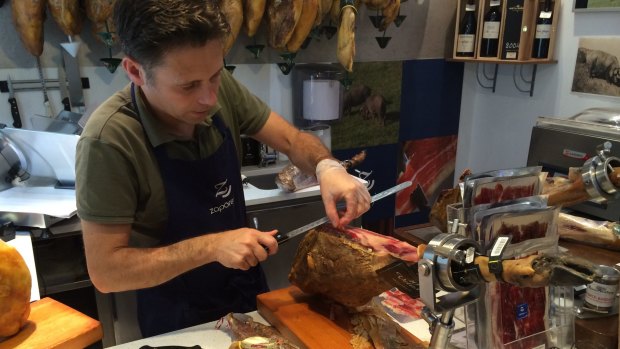This was published 8 years ago
Jamon iberico de bellota: How to carve the world's best ham
By Ben Groundwater

Master meat magician Sylvain at work.Credit: Ben Groundwater
Sylvain is obviously proud. "I was trained by a champion of Spain," he says, withdrawing his jamonero, or ham-slicing knife, from its sheath, preparing to begin the demonstration. "I've been doing this now for about 15 years."
He's standing in front of a carefully positioned leg of jamon iberico, that famous Spanish ham, its black hoof clamped into a brace, its meaty upper side exposed and ready for slicing. There's an air of reverence in the room – this isn't just any old jamon iberico we're about to slice up, but a "5 Jotas" jamon iberico de bellota, the very best of the very best. The pig was raised on a certain pasture near Seville; it was fed only acorns; its rich, sweet meat is coveted around the world. And it's ours.
Sylvain takes hold of a smaller, dagger-like knife, the puntilla, and plunges it into the flesh up near the hoof. With two small swivels he's made a deep slice down to the bone – that's where the carving will begin. "From here," Sylvain says, "you begin to carve off the excess fat. You run the knife blade down the leg like this, and keep removing strips of fat."
If this sounds like an intricate process, like something of a science, it is. That there could possibly be a Spanish champion in cutting meat sounds ridiculous, but it's absolutely true. In Spain, the jamon is king, and the cortador, the cutter of the ham, is its most revered servant.
This is a profession that's passed from father to son. It's something that requires an apprenticeship of years. It's an art form that must be perfected, its greatest exponents becoming honoured artisans.
My friend Matt and I are in the presence of greatness. Sylvain is Basque, a Frenchman who was born just across the border from here in San Sebastian, and who grew up in this region of rolling green hills and beautiful beaches. The art of the cortador wasn't passed down through his family, but rather something he chose to learn, travelling to Andalusia, the home of the jamon, to learn the art of carving from a Spanish champion.
And this is the fruit of 15 years' labour: perfectly sliced jamon. Sylvain now runs a small store in San Sebastian, one of those places with legs of ham hanging from the ceiling and knives and brackets lining the walls.
Matt and I are here on a whim. Matt's been living in San Seb for the last couple of months, and has suddenly decided that he can't leave without having one quintessentially Spanish experience: owning a whole jamon iberico. So we've come down to Sylvain's shop to buy such a thing, as well as to learn what to do with it once we get it home. It's going to be a challenge.
"You'll be OK," Sylvain says. "But it usually takes three, maybe four hams to get the hang of it."
In other words, we're probably going to butcher this one. To properly enjoy jamon iberico, each slice needs to be paper thin, a bite-sized portion with no more than a centimetre-wide strip of fat. To do otherwise with a masterwork of pork production would be a travesty. Sorry, will be a travesty. This will be like Picasso sketching out a picture and giving it to Matt and me to finish off.
But that's all part of the experience. For us visitors, this indulgence is a journey into Spanish culture that you can only get by shelling out a lot of money. It's an outlandish purchase, a ridiculous purchase – but sometimes they're the best kind.
Plus the good news is that Matt's paying the bill, because this leg of ham, plus the bracket and two knives, costs $830. Sylvain says we'll get about 2.5 kilograms of meat off it, which should last us a few months. (We'll go on to prove him wrong, however, knocking the whole leg off in a couple of weeks.)
The slicing Sylvain is doing is a way getting the hard part done for us – removing the fat and carefully slicing to where the meat begins – so that we can go home for the glory of freshly sliced jamon iberico de bellota.
With deft cuts, first with the short, sharp puntilla, then with the long, narrow jamonero, he carves away strips of buttery, melting fat, before exposing the rich meat beneath. Then it's our turn. Sylvain hands over the jamonero, and I attempt to carve off the perfect portion of jamon, slicing towards me like I've been shown, easing the blade through the meat, and going far too deep, hacking off a chunk about three times as thick as it should be.
Sigh. I'm no Spanish champion. But I have a lot more respect for those who are.
b.groundwater@fairfaxmedia.com.au
See also: The best country in the world for food
See also: The food store that could change your life
Sign up for the Traveller Deals newsletter
Get exclusive travel deals delivered straight to your inbox. Sign up now.